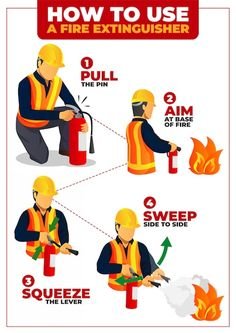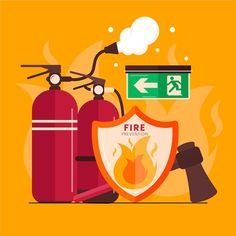Hotel Management Class Notes 45
Choosing and Using Fire Extinguishers:

When selecting a fire extinguisher, consider the potential fire hazards present in your environment and ensure that the extinguisher is appropriate for the classes of fires likely to occur. Understanding the following key elements will help you effectively use a fire extinguisher:
- PASS Technique:
- Pull the pin: Pull the pin at the top of the extinguisher to break the seal.
- Aim low: Aim the nozzle or hose at the base of the fire, not at the flames themselves.
- Squeeze the handle: Squeeze the handle or lever to discharge the extinguishing agent.
- Sweep from side to side: Sweep the nozzle or hose from side to side until the fire is extinguished. Continue to watch for re-ignition.
- Safety Precautions:
- Ensure you have a clear escape route and never allow the fire to come between you and the exit.
- Always approach a fire with caution and be prepared to evacuate if the fire becomes uncontrollable.
- Use the appropriate type and size of extinguisher for the fire. Using the wrong type can be ineffective or dangerous.
- Never turn your back on a fire until you are certain it is fully extinguished.
- Maintenance:
- Regularly inspect fire extinguishers to ensure they are in good working condition.
- Check the pressure gauge monthly to ensure the extinguisher is charged and ready for use.
- Schedule professional maintenance and servicing according to manufacturer guidelines.
Fire Safety Practices:
Beyond fire extinguishers, implementing comprehensive fire safety practices is essential to minimize fire risks and ensure a safe environment:

- Fire Prevention:
- Keep flammable materials and sources of ignition away from each other.
- Store flammable liquids and gases in approved containers and away from heat sources.
- Maintain electrical equipment and wiring to prevent overheating and electrical fires.
- Smoke Alarms and Detection:
- Install smoke alarms in key areas of your home or workplace and test them regularly.
- Ensure smoke alarms are interconnected so that if one sounds, they all sound.
- Replace smoke alarm batteries annually or as needed.
- Emergency Evacuation Plan:
- Develop and practice an emergency evacuation plan with all occupants or employees.
- Designate primary and secondary evacuation routes and assembly points.
- Ensure everyone knows how to respond to fire alarms and emergency notifications.
- Training and Education:
- Provide fire safety training to employees, tenants, or household members.
- Train individuals on the proper use of fire extinguishers and evacuation procedures.
- Conduct fire drills regularly to practice response and evacuation.
- Fire Safety Equipment:
- Ensure adequate fire safety equipment is available, including fire extinguishers, fire blankets, and emergency exit signs.
- Maintain clear access to fire exits and keep them free from obstruction.
Conclusion:
Fire extinguishers are vital tools in fire safety, allowing individuals to intervene quickly and effectively in containing small fires before they escalate. Understanding the types of fire extinguishers, their appropriate uses, and practicing safe handling techniques can make a significant difference in protecting lives and property. Coupled with comprehensive fire safety practices and education, including prevention, detection, and evacuation planning, fire extinguishers contribute to a proactive approach to fire safety that enhances overall preparedness and minimizes risk in residential, commercial, and industrial settings.
